Lessons about nomadic life in the Gobi Desert’s wilds and how using modern technology helps the nomads survive.
When I visited the nomads in the Gobi Desert in Mongolia, I expected everything to be very primitive and poor. I was pleasantly surprised to learn the new type of Mongolian nomadic herders used a lot of modern technology.
Table of Contents
- Who Are The Nomadic Herders Who Live in Mongolia and Use Yurts (Gers)
- Rounding Up The Herds With Dirt Bikes At A Mongolian Nomadic Herders Camp
- Mongolian Nomadic Herders and Using Modern Technology
- Frequently Asked Questions
- Related Questions
The Mongolian nomadic family we stayed with had dirt bikes to round up their herds; the husband and wife were University graduates.
They chose to live the life of a nomadic herder while at the same time using technology to help them manage their herds; they believed in using as much modern technology as possible, as they had everything from cell phones to computers and television that got decent reception. They had solar panels around the yurt (ger) campsite to charge and use all these electrical appliances.
Who Are The Nomadic Herders Who Live in Mongolia and Use Yurts (Gers)
Hidden away in the vast, rolling steppe of Mongolia is a group of herders who live tethered to their nomadic lifestyle. The grasslands around them offer expansive views that stretch for miles and, in turn, provide shelter from the elements with their yurts – also known as gers – providing watertight minimalism capable of withstanding sub-zero temperatures, fierce winds, and brutal snowstorms.
Every season these Mongolian nomads must migrate hundreds of miles and settle into unpredictable landscapes all over again – but why? If we look beyond this unique way of life here on our connected planet Earth, we can find a deeper understanding of the practical applications and social dynamics underpinning why people choose to live on wheels.
We explore this genuinely new kind of Mongolian nomadic herder who is educated and uses dirt bikes and modern technology. It was not the kind of Mongolian nomadic herder I was expecting to see in the Gobi Desert of Mongolia.
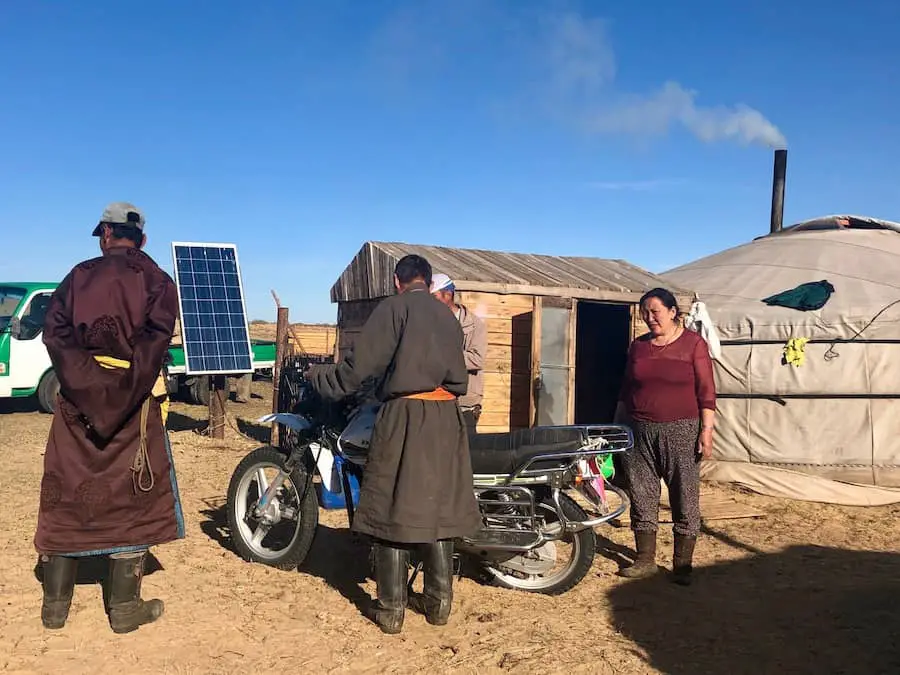
The Modern Face Of The New Mongolian Nomadic Herders
When many of us think of nomadic herders, we may think of people who are uneducated and have no choice but to be a nomadic herders. We may feel that they grew up as a nomadic herder, so they wanted to stay as a nomadic herder as that was the only life they had ever known.
After all, we would wonder why anyone would choose to live in a tent or a yurt or what they call a ger and have to pack up and move about four times a year. And the toilet was a hole in the ground that did not even have a door on the stall. If you needed to take a nighttime trip to the bathroom, there were no lights to light your way.
Water was limited or nonexistent as there was no well, so any moisture you used would have to bring in. You can forget about a proper bath or shower; there was just insufficient water.
I soon discovered that these nomadic herders had a choice. I was surprised when I found that the Mongolian nomadic herders I stayed with, both the husband and wife, had University degrees and worked and lived for a time in Ulaanbaatar – Mongolia’s capital. These Mongolian nomadic herders had an option in that they were both highly educated, but they chose to live life as nomadic herders.
I asked them why they did not work in the city and the professions they had been educated in. They told me it was about the wide-open spaces, the freedom, and the way of the nomadic lifestyle for them; they choose to be nomadic herders.
There is a great community support system among the Mongolian nomadic herders. I am sure part of the draw for many of the herders may be the support they have in their community with other herders. Nomadic herders are there helping their nomadic neighbors in their time of need.
To find out more about this community support system, you can read our blog entitled Community Support Lessons from Nomadic Herders in Mongolia by clicking here.
I am sure that having an education has helped them be successful in their nomadic herding business. After all, being a nomadic herder is a business that needs to be run as a small enterprise.
They have herds they must tend to and understand about their health and well-being. They must also know about wool or cashmere prices as they sell their cashmere and wool yarns to the highest bidders. They also need to be able to handle their business accounts.
This family also ran a horse riding and camel business. The wife of the nomadic herding family had an accounting degree and had worked as an accountant, which I am sure has come in handy as they have run their business.

The husband was an engineer, and I could see around the campsite where he had used his engineering degree to help improve their ger or yurt camp. As I looked around at their camp, I felt like this was the face of the new Mongolian herder – they are nomadic herders who are educated and have University degrees. Yet, they are using their degrees to live the traditional nomadic lifestyle.
Sometimes, looks can be a bit deceiving. When you look at the nomads, you see them in their nomadic clothes and Russian leather boots. You may think they do not know or understand the world, but I discovered nothing could be further from the truth.
These nomadic herders are tapped into much of what is happening worldwide. They may live out in the middle of nowhere, but that does not mean they do not understand the world.
I asked my nomadic herder friend where he got the outfit he wore, and he proudly told me that his wife had made it. In times past in America, I thought of how we would have had similar stories on the farms and in our farming communities.
The sewing machine was in the corner of their yurt (ger), and the rolls of fabric were somewhere else so that the wife could lovingly make her husband what he needed to go about and do his daily work with the herds.
Maybe their life as a nomadic herder is not so different from many places in America, Europe, and other parts of the world. We may have a lot more in common than we think we have.
But being a nomadic herder was not without pain. Mongolia’s winters are cold and bitter, so this family lost 30 horses in one winter. That is a small fortune for any herder. To read more about this, you can read our blog entitled 5 Lessons in Grit and Perseverance from Nomadic Herders in Mongolia by clicking here.
Rounding Up The Herds With Dirt Bikes At A Mongolian Nomadic Herders Camp
Before I came to Mongolia, I had visions of nomadic herders rounding up their herds by walking or riding another animal as a horse. However I quickly learned that these nomadic herders were using modern technology as much as they could to ensure their success. They knew exactly what worked and why it worked.
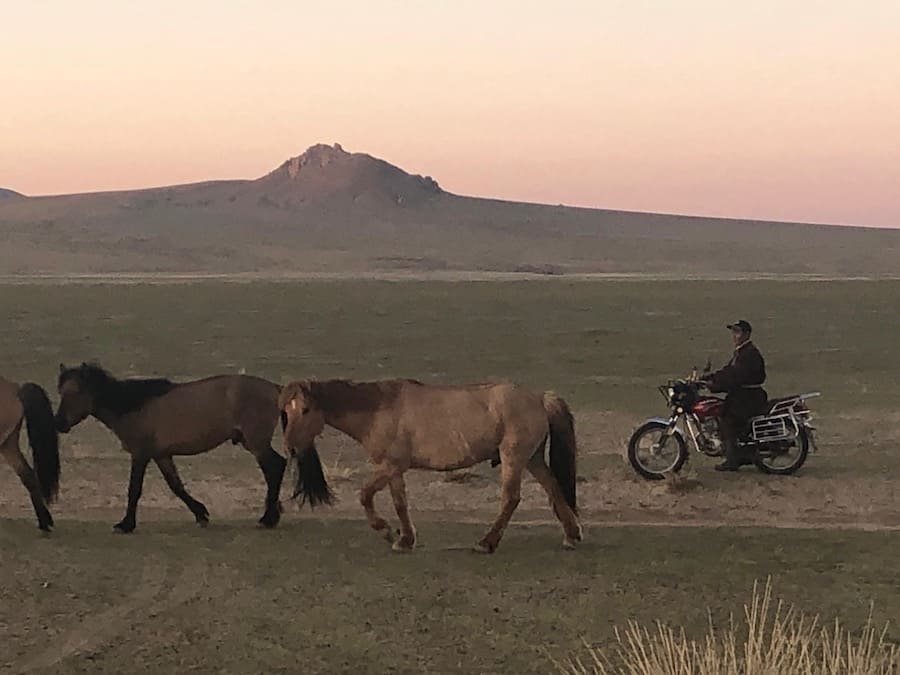
These nomadic herders used dirt bikes to be able to go about their daily work. They would go about their daily work going back and forth to their herds on their dirt bikes.
But this area had no proven paths or trails. They were out there in the desert’s wilds on unproven paths. They did not just go out to ride dirt bikes on the weekend but were there daily.
This was like a daily motocross ride. They had no special helmets, fancy gear, or pads to protect them just in case they fell. For them, this daily riding was like the ultimate daily motocross race, except without any rules, regulations, or special gear.
Their most important rule was not to get injured and not get lost. If they got lost, there was no 911 or rescue party, or search organization they could call. They would have to find their way back.
Getting injured or lost could quickly happen in the terrain and territory they were dirt bike riding as they rode through many large and small dunes along with a host of other terrains in the vast Gobi desert.
They would still bring out these dirt bikes in the snow and bitter cold. To me, they were like the very ultimate adventure motocross dirt bike riders.
I thought of how amazing it was that they could use modern technology to their advantage and help them accomplish their daily work. The Mongolian nomadic herders had found that using dirt bikes as a way that would help them with their daily work.
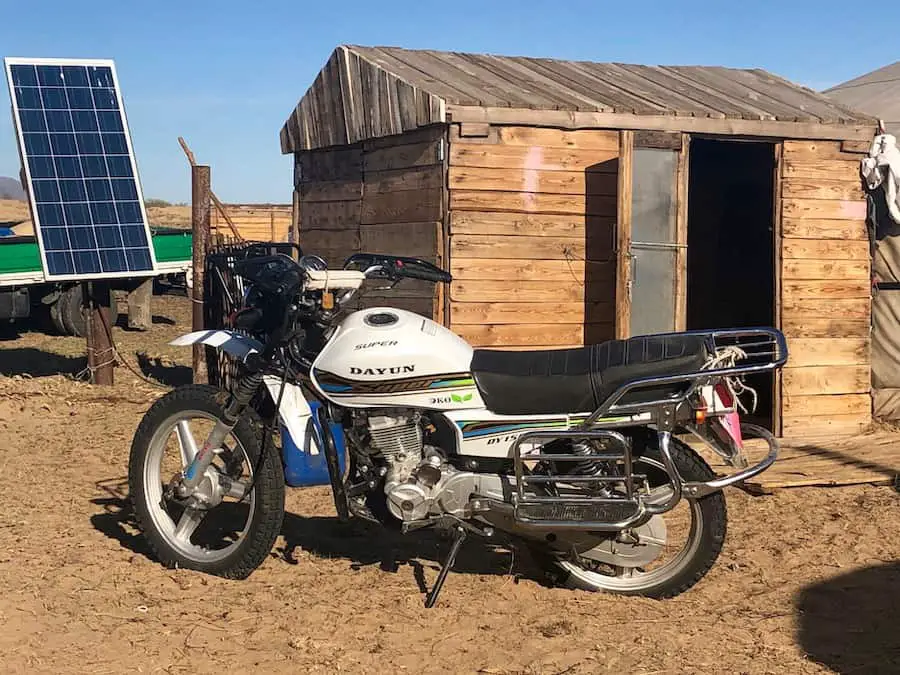
I discovered that my nomadic herders also have dirt bikes, but it seemed that most of the nomadic herders around the area were dirt bike riders. Dirt biking out in the Gobi desert over the sand dunes seemed like the ultimate adventure and adventurous lifestyle. Maybe this was part of why so many chose to be nomadic herders; each day would bring a new adventure.
Mongolian Nomadic Herders and Using Modern Technology
Every nomadic herder I saw had a cell phone to text, receive messages, get phone calls, and assume, if needed to receive some emails, read the news, and check up on other events. I thought of what a great equalizer technology is in that they could be out there in the middle of nowhere in the Gobi Desert of Mongolia; they could send and receive messages, make phone calls, and find out what was happening in Mongolia and worldwide.
Their yurt or ger also had a television. After they came in at night, after rounding up the herds, they sat down, ate their dinner, and started to watch the Mongolian evening news.
I thought this was not too different from what many of us would do in the west. We would get our dinner and then watch the evening news. When the news was over, or they had watched enough news, they promptly switched the channel to a segment on horse racing.
As they call them in Mongolia, the yurts or the ger’s have no electricity or access to electricity. At the same time, the herders need electricity for their lights and charge their cell phones, television sets, and other small electrical appliances.
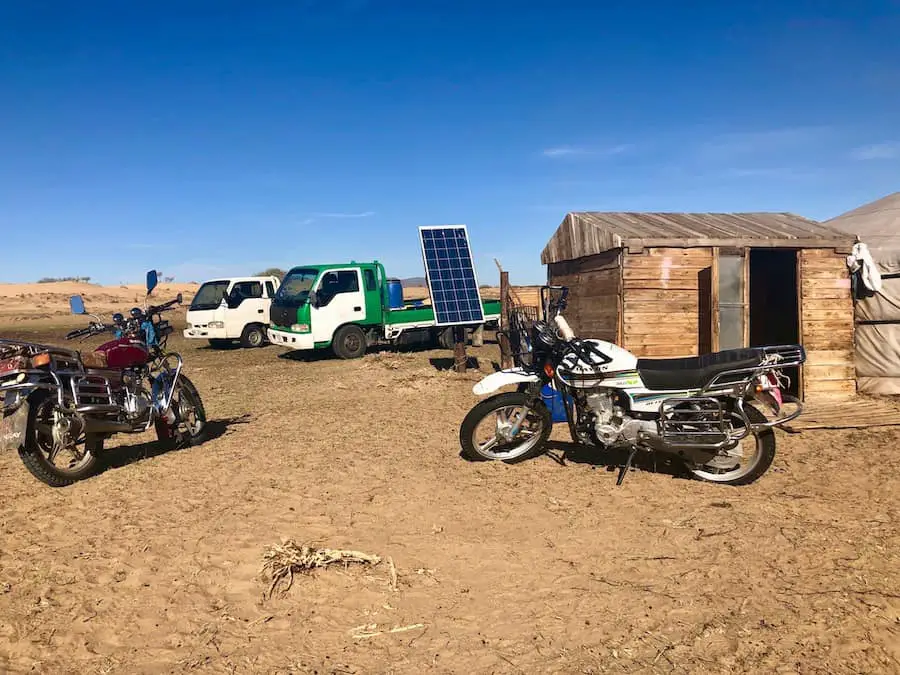
What is their solution to this problem? The Mongolian nomadic herders have all gone to completely green power by using solar panels for electricity.
Solar panels lined the ger camp since no other means of electricity were available. To use their electrical devices, they had to find a way to bring electricity into the camp in the most economical way, which ended up being solar power.
Watching how the nomadic herders used all the modern conveniences to do their work was fascinating. They were smart, knowledgeable, educated, and in touch with what was happening around them and in the world.
They knew that to be able to survive out there in the wilds of the Gobi desert, they had to use every single tool that was available to them. This included using dirt bikes to round up the herds and get around the area, plus other modern technology aspects, including solar panels, to ensure they had enough electricity for their modern-day technical devices.
I could see why many of these nomadic herders chose to live this nomadic lifestyle. There was a real sense of adventure about going out there daily and dirt biking around this very wild and untamed terrain.
At A Bus On A Dusty Road, we talk about everything about travel, life, and ex-pat living. We are all about “Living Life As A Global Citizen.” We explore social, cultural, and economic issues and travel.
We would love to have you be part of our community. Sign up for our newsletter to keep up-to-date by clicking here. If you have any questions, you can contact me, Anita, by clicking here.
Listen to our Podcast called Dusty Roads. You can find it on all major podcast platforms. Try out listening to one of our podcasts by clicking here.
Subscribe to our A Bus On A Dusty Road YouTube Channel filled with great videos and information by clicking here.
Frequently Asked Questions
Can I do a dirt bike tour through Mongolia?
Many tour companies offer dirt bike tours in Mongolia. These tours usually have you stay out in the Yurt (Ger) with a Mongolian nomadic family. This way, you will be able to see the life of the nomads in Mongolia.
Many of these tours may include other activities like camel riding, horseback riding, archery, and trekking. If you are near a lake, you may also be able to get in some fishing.
If you love the countryside and nature, Mongolia is a must-see location for your international travels. We recommend a tour company called New Milestone Tours; you can contact them and speak to Adiyabold by clicking here. You can tell Adiyabold that Anita sent you.
How many more animal livestock than people are there in Mongolia?
Mongolia is said to have over 66 million livestock. There is a lot of sheep, goats, horses, yaks, and camels. The population of Mongolia is just over 3 million people. It is the most sparsely populated sovereign state in the world.
Once you get outside the capital city of Ulaanbaatar (Ulaanbaatar has about 1.5 million people or half the Mongolian population lives there), there are far more livestock and animals in the Mongolian countryside than there are people.
How many types of animals are in Mongolia?
If you want to see the widest variety of animals globally, Mongolia is a place to go.
Mongolia has the following:
There are about 139 species of different kinds of mammals;
Mongolia is known to have at least 450 species of birds
About 331 of the bird species are migratory, and 119 birds live in Mongolia year-round.
Mongolia has at least 22 different species of reptiles;
And 6 species of different kinds of amphibians;
Along with over 75 different species of fish.
So if you love wide-open spaces, want a great adventure, and have the desire to see a great variety of wildlife – Mongolia is the place to visit.
What is Mongolia known for?
Mongolia is famous for its vast steppes, nomadic culture, the Gobi Desert, and its history connected to the Mongol Empire led by Genghis Khan. It’s a country rich in natural beauty and traditional lifestyles.
Where is Mongolia located?
Mongolia is a landlocked country located in East and Central Asia, bordered by Russia to the north and China to the south.
What is the lifestyle of Mongolian nomads?
Mongolian nomads live a pastoral life, herding livestock such as goats, sheep, cattle, horses, and camels. They move seasonally to find better grazing grounds and live in portable tents called gers or yurts.
What is the traditional dwelling of Mongolian nomads?
Traditional Mongolian nomads live in gers, also known as yurts, which are circular, portable tents designed for easy assembly and disassembly, suitable for their nomadic lifestyle.
What is the capital of Mongolia?
The capital of Mongolia is Ulaanbaatar, which is the largest city in the country and the cultural, industrial, and financial heart.
What are the main industries in Mongolia?
Mongolia’s main industries include mining (especially coal and copper), agriculture, and tourism. The country is rich in natural resources.
What languages are spoken in Mongolia?
The official language of Mongolia is Mongolian, and it is predominantly spoken across the country. Russian and English are also taught in schools and are common second languages.
What is the climate like in Mongolia?
Mongolia has an extreme continental climate, characterized by long, cold winters and short, warm summers. The country is known for its wide temperature fluctuations, both seasonally and daily.
Can tourists visit Mongolian nomadic families?
Yes, tourists can visit Mongolian nomadic families. Many tour operators offer cultural experiences that include spending time with nomad families, learning about their way of life, and even staying in a ger.
Related Questions
Mongolia Vs. Inner Mongolia: What Is The Difference?
Mongolia is an independent country that gained full independence when the Soviet Union dissolved in 1990. Inner Mongolia, also known as the Autonomous Region of Mongolia, is part of China. The people who live in Inner Mongolia are considered Chinese citizens. In contrast, the people who live in Mongolia are considered Mongolian citizens. Even if they may speak the same language and have a similar culture, they are two different countries.
You can learn more by reading Mongolia Vs Inner Mongolia: What Is The Difference? by clicking here.
How Long Has Mongolia Been A Country?
In 1911 Mongolia broke from Chinese rule; in 1921, the socialist People’s Republic of Mongolia was formed. The People’s Republic of Mongolia was a satellite state of the Soviet Union. When the Soviet Union broke apart in 1989, Mongolia’s fate again changed. In 1990, Mongolia, an independent and democratic country, was formed; its official name is Mongol Uls.
You can discover more by reading How Long Has Mongolia Been A Country? by clicking here.

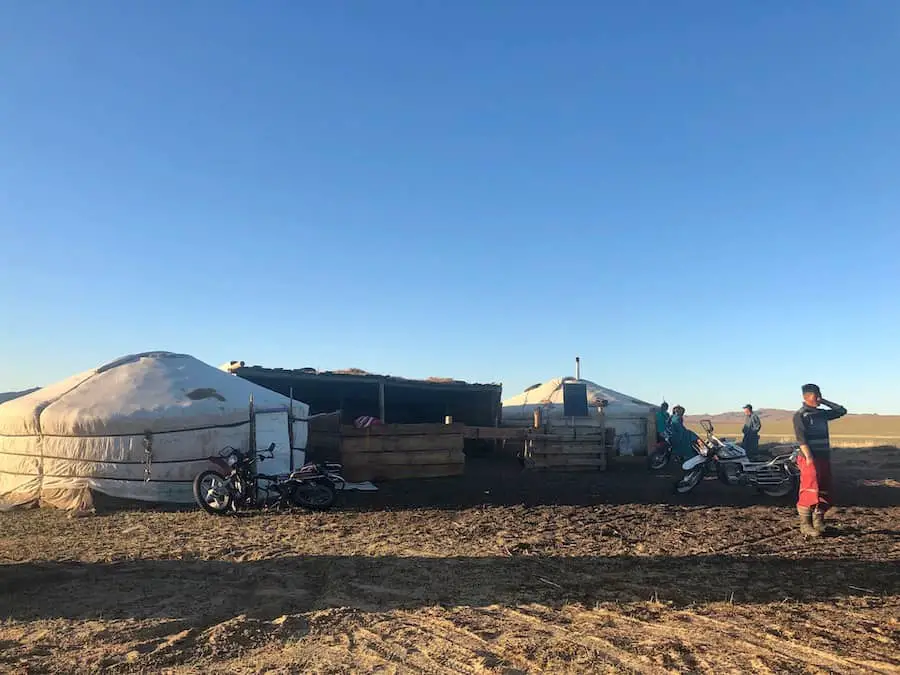

2 responses to “Nomadic Herders Who Live In Mongolia And Yurts (Gers)”
Thank you for your sharing. I am worried that I lack creative ideas. It is your article that makes me full of hope. Thank you. But, I have a question, can you help me?
Thanks for sharing. I read many of your blog posts, cool, your blog is very good.